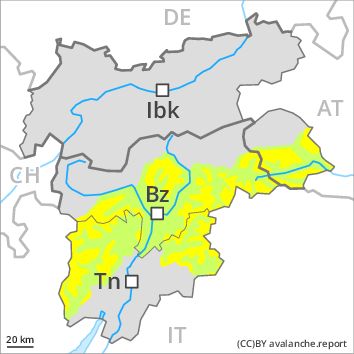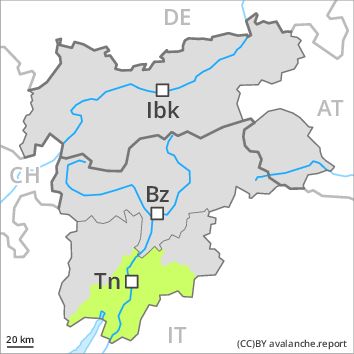Regions
Sexten Dolomites, Latemar, Western Deferegger Alps, Ulten Valley, Eastern Nonsberger Alps, Northern Dolomites of Fiemme, Gröden Dolomites, Southern Adamello, Primiero - Pale di S. Martino, Eastern Deferegger Alps, Prags Dolomites, Sarntal Alps, Adamello - Presanella, Schober Mountains, Northern Brenta - Peller, Lienzer Dolomites, Western Nonsberg Alps, Southern Brenta, Fassa Valley, Sole, Pejo and Rabbi, Northern Lagorai, Maddalene

Danger level
Avalanche Problem
Wind-drifted snow above the treeline, N-NE-E-SE-NW
Wet snow above 2600m, SE-S-SW-W

Fresh wind slabs require caution. As a consequence of warming during the day the avalanche prone locations will become more prevalent.
The more recent wind slabs can still be released in particular on steep shady slopes above the tree line. As a consequence of warming during the day small and, in isolated cases, medium-sized moist and wet avalanches are possible. They can be released in the weakly bonded old snow in particular in areas where the snow cover is rather shallow. In particular transitions from a shallow to a deep snowpack where weaknesses exist in the old snowpack are precarious.
Snowpack
dp 6: cold, loose snow and wind
The strong wind has transported the fresh snow significantly. Especially above the tree line mostly small wind slabs formed. Faceted weak layers exist in the snowpack in particular on steep shady slopes. At high altitudes and in high Alpine regions the avalanche prone locations are more prevalent.
Tendency
Gradual increase in danger of dry and moist avalanches as a consequence of warming during the day and solar radiation.
